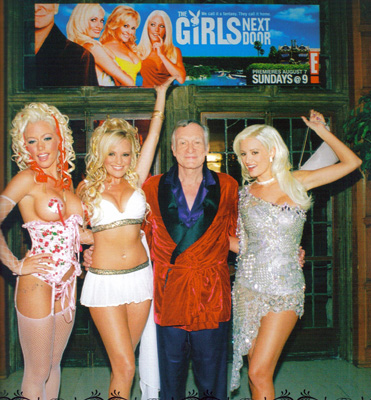 |
Rose defines psychoanalysis as, "a range of theories that deals most centrally with human
subjectivity, sexuality and the unconscious...[it pays] close attention to visual images,
and [is] centrally concerned with their social effects: the ways they produce particular
spectating positions that are differentially sexualized and empowered" (Rose 107). Using
psychoanalysis, I will examine how the images of these women (individually and when accompanied
by Hugh Heffner) shape the beliefs, opinions and actions of the viewer. I will also show how the
television show helps to re-enforce concepts of patriarchy, phallocentrism and the "male gaze"
in society.
Rose discusses the term phallocentrism, or the idea that modern day culture is structured in and around masculine and
patriarchal terms. The idea of the "male gaze" is very much at work in society today, as it, "projects its fantasy onto
the female figure, which is styled accordingly" (Rose 115). The very first image encountered in Paul Ruditis' biography
of The Girls Next Door supports the ideas of phallocentrism and the male gaze, because of how the girls are situated,
the camera angle, what they are wearing, what they are doing with the objects in their hands, as well as the expressions
on their faces. |
The camera angle from which the photograph of the three women was taken is from above, looking down upon them. This
produces the feeling that the viewer is objectifying and distancing himself from the subject (the three girls), as
opposed to if the picture was taken from the ground looking up, or even simply on the same physical level as the
three girls are on. Rose discusses voyeurism as, "a way of seeing that is active; it distances and objectifies what
is looked at. It is controlling and even sadistic..." (Rose 117). The angle at which the women were photographed
at produces a voyeuristic feeling, as though one is peering down on the women, and there is a certain distance
between them and the viewer. A much different feeling for the entire book would be achieved through a non-voyeuristic
photograph, of the women, for example, a simple close up of their faces on the same, parallel level as the viewer.
|
The girls are scantily-clad, each wearing short bright colored shorts, and bikini bathing suit tops or (in Kendra's case)
simply a bra. It is in fact hard to distinguish if the women are wearing nothing but undergarments, or if they are
wearing swimwear on top, which is considered more acceptable that simply wearing a bra and nothing else. The girls
are all posed in seductive, but not overly-sexualized poses; each are laying on their side, Holly and Bridget each
have an arm slightly covering their torso which is at an angle. Kendra is positioned in a more advertly sexualized position,
as her torso faces directly towards the viewer, no arms covering her torso, and her legs are pointed more directly at the
viewer. Each of the three have smile on their face, not an overly-friendly smile, but an inviting, slightly seductive smile on
each of their faces. The combination of these aspects is not to force, but to invite the male gaze upon each of the girls,
and on the group as a whole.
Rose discusses the, "notion that the penis is not simply a piece of anatomy but also something meaningful" (Rose 114).
This idea is referred to as the phallus, and is related to phallocentrism in that men are defined by possessing this
indicator of sexual difference, and women are defined as lacking, castrated, or non-men. On the cover photograph of
The Girls Next Door book, each woman holds something in her hand. Bridget is holding onto the stem of a flower which
he is picking the petals off of. This is in reference to a relatively well-known childhood game, in which young girls
pick petals off of a flower, repeating the phrase "he loves me, he loves me not" in order to determine if the boy they
have a "crush" on likes them back. Bridget makes direct eye contact with the viewer in the photograph, thus asking a
direct question to the viewer: do you love me or love me not? This little "game" although simple in nature, employs
the phallocentric ideas that society and relationships are centered around the male, and by the male. The game is not
known as, "she loves me, she loves me not," but rather the male or "he" figure that actively determines or initiates
the relationship. |
 |
Holly and Kendra each hold what is most directly represented as the presence of the "phallus" or man in the photograph,
each holding a brightly colored popsicle in their hands. Neither one of the women are actually eating or licking the
popsicle, but it is simply held in their hands as more of a prop or symbol. Throughout the episodes of the show,
Hugh Hefner mentions that when Playboy models are photographed for the magazine, he always includes the "presence of a man"
somewhere in the background of the photograph. For example, in one episode Holly assists in the photo shoot of a playmate,
she adds two martini glasses in the background, one filled with a pink drink to indicate the female, and one filled with
a blue drink to represent the male. She comments on how she thought to add two martini glasses instead of one, because
she knows Hef always requires the "presence of a man" somewhere in the photograph. While Hugh Heffner may not have
specifically directed the women to hold popsicles on the cover photograph of the book, there certainly is presence
of a man, or as the popsicles represent - presence of the phallus. The photograph of the three women on the cover,
and many other photographs of the three together, serve to re-enforce ideas of phallocentrism, patriarchy, and the
"male gaze" that is prevalent in society.

